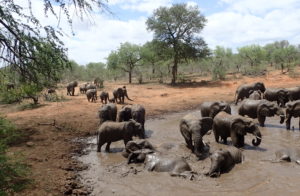Honeybee pheromones safely repel elephants, study finds
An organic formulation containing honeybee pheromones has been found to safely repel elephants, offering promise for a new strategy to prevent the world’s largest land animals from destroying crops or causing other damage in areas where humans conflict with elephants, according to a study published July 23, 2018 in Current Biology.
The study was conducted at Greater Kruger National Park in South Africa between December 2017 and February 2018.
The scientists placed a blend of pheromones developed by ISCA Technologies that bees release when they perceive danger in a specialized slow-release matrix at locations around waterholes frequented by African bush elephants, Loxodonta africana. The researchers observed that most of the elephants that came near the formulation showed typical signs of increased alertness, signs of uncertainty, and finally calmly moved away, while those approaching control treatments were eager to investigate the foreign object in their environment. The pheromones were dispensed in white socks weighed with rocks hanging from broken tree branches no more than a meter off the ground.
At the park’s Jejane waterhole, 25 of 29 elephants that approached the pheromone-laden socks moved away after getting close enough to smell the formulation. In the same timeframe, control experiments found that all elephants ignored similar looking suspended socks that did not contain the pheromone mix, or they would approach the controls and pick them up, and even try to taste them in some cases.
“Our results complement previous studies that have demonstrated that active bee hives can deter elephants from crops for example but may be difficult to implement on a large scale. We hope to expand this work to develop additional tools for sustainable passive management of elephant movements, to augment the current approaches used.,” said Mark G. Wright, the lead author of the study and a professor of entomology at the Department of Plant and Environmental Protection Sciences at the University of Hawaii at Mānoa.
“We were pleased with the results of the elephant study and hope our bee pheromone formulation will save elephants while also helping farmers,” said study co-author Agenor Mafra-Neto, president and CEO of ISCA Technologies Inc. in Riverside, Calif.

“We were also amazed that we actually could effectively manipulate the behavior of these huge animals using the chemical signal of tiny insects,” Mafra-Neto said. “Imagine being able to use environmentally safe pheromone formulations, similar to those that we use today to control agricultural insect pests, to manage and control large mammals.”
This study was a collaboration between scientists at the University of Hawaii at Mānoa, the Balule Nature Reserve in South Africa, University of South Africa, Elephants Alive in South Africa, and ISCA Technologies, a Riverside, Calif., a biotech company that prepared the pheromone formulation in a slow release matrix called SPLAT™ .
This study stemmed from ISCA’s two decades of research, development, and commercialization of products that use pheromones and other naturally-occurring compounds that manipulate animal behavior to control insects that destroy crops or spread diseases without a need for area-wide spraying of toxic pesticides. This study, however, breaks new ground by showing that synthetic pheromones also may have the potential to be used to safely manage a large mammal species.
The need for safe elephant management strategies has become more pressing as human populations have grown in Africa and Asia creating larger areas where elephants conflict with humans by trampling crops or causing other damage. These conflicts are often tragic. People have been trampled to death, and their crops are destroyed. And elephants deemed to be destructive are often killed.
In this study, the scientists exploited the chemical clues that occur in nature. When a mammal appears to threaten a beehive, bees that perceive the threat release from their bodies “alarm” pheromones to marshal other bees to defend the hive. A swarm of bees then attack and sting the mammal.
Elephants hate to be stung, Wright said. The soft tissues in their eyes and inside their trunks are particularly vulnerable to painful bee stings. So, over the eons, it is believed, elephants learned to recognize the odor of bee alarm pheromones and to back off when they come across them.
In fact, some farmers in Africa place commercial bee hives along their fence lines to protect crops from elephants. Yet, the use of manufactured pheromones in a slow-release matrix could be far less costly, more flexible, and easier to deploy to facilitate safer coexistences between elephants and humans in habitat interface areas.
Contact:
Agenor Mafra-Neto
President and CEO, ISCA Technologies
951-686-5008, office
president@ISCAtech.com
Mark Wright, Professor of Entomology
Department of Plant and Environmental Protection Sciences
The University of Hawaii at Mānoa
(808) 271-2037, cell
David Danelski, Communications Director
ISCA Technologies
951-686-5008, office; 951-850-0143, cell
Keywords: pheromones, ISCA, elephants, bees, habitat, Africa, Kruger, habitat
About ISCA Technologies: ISCA is the world’s largest semiochemical insect pest management products producer that targets row and forestry crops. ISCA Technologies, Inc. is a privately held biotech company based in Riverside, Calif., that develops, manufactures and commercializes safe, economical, environmentally friendly, and highly effective control solutions to crop-destroying and disease-spreading pests worldwide through the use of naturally occurring compounds that influence animal behavior. ISCA’s revolutionary pest controls don’t harm non-targeted species and drastically reduce or, in many cases, even completely replace pesticide applications. For additional information, visit us at www.iscatech.com.
